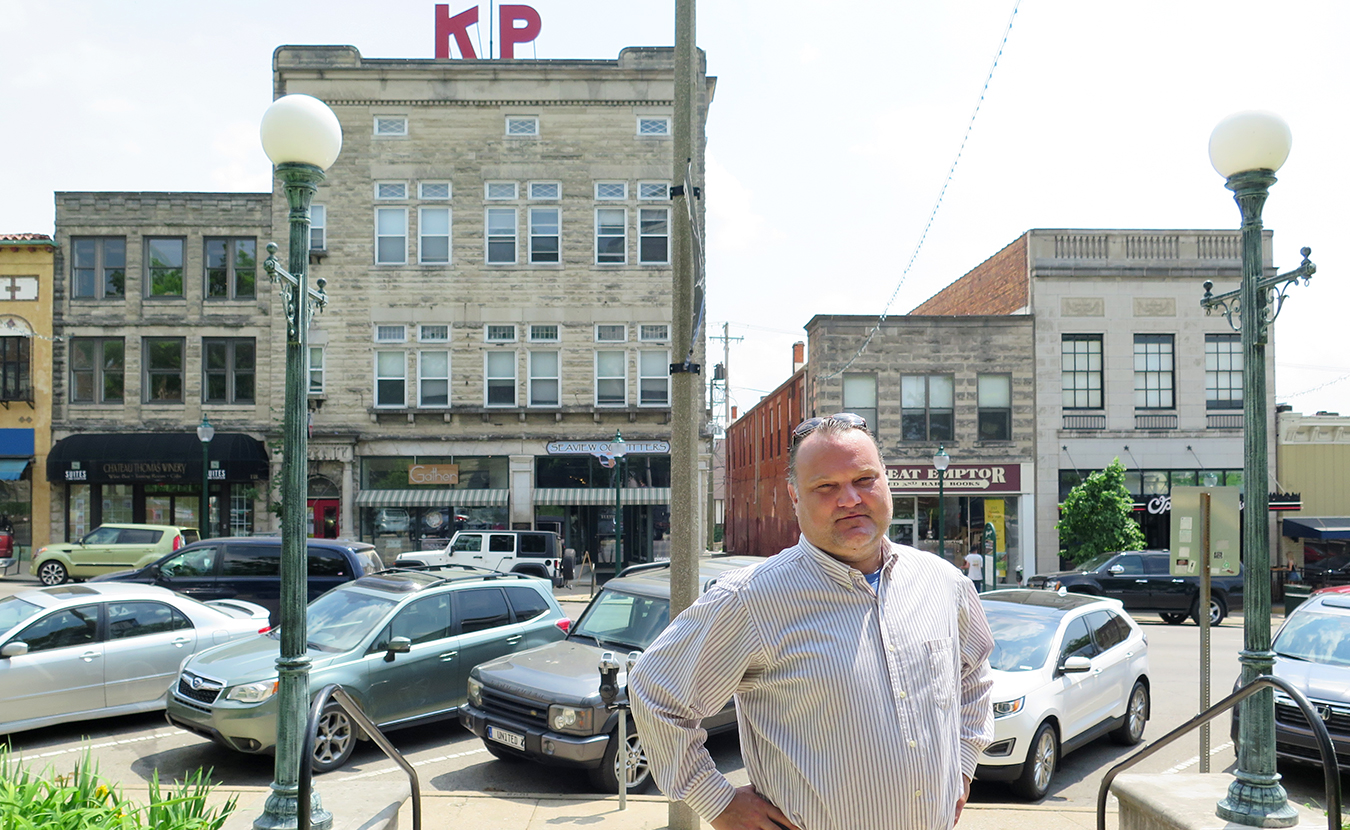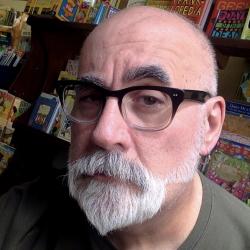Derek Richey arrived in Bloomington in 1991. Early on, he decided to take a walk down College Avenue, to take in the lay of the land that would become the first permanent home he’d ever had. He began walking southbound up around 11th Street, where, behind him, to the north, the roadway crossed under an old railroad line. An unused ramshackle station still stood on the west side of the crossing. History was one of Richey’s passions, even though he was a kid just about to begin his first year at Indiana University.
“As I headed south,” he says, “there were just empty lots. And more empty lots. And parking lots. There was a dog-grooming shop that used to be an old A&W Root Beer, but outside of that it was just pavement on the whole east side of the street. I kept thinking, ‘Gosh, what happened to this town? Why is there so much pavement here?’”
The questions nagged at him for the next two decades. He began to find answers only when he and his young son, Nick, started taking photographs around Bloomington around 2010.
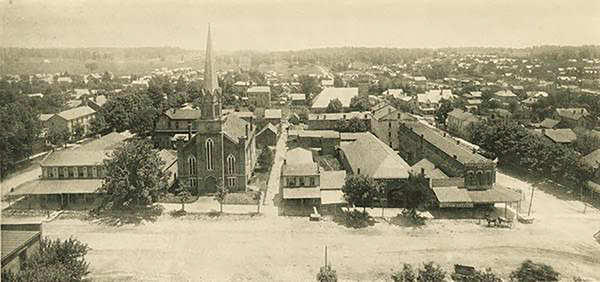
The east side of the downtown Square in 1891. The Indiana University Archives has labeled the buildings from left to right: “Faulkner House Hotel (at corner with covered sidewalk); meat market (behind tree); First Presbyterian Church; alley; bakery, barber shop; feed store ?; J. H. Kirby’s Meat Market; grocery store (the tall white building behind the grocery store is the old National House Hotel at 113 thru 121 East Kirkwood. In later years this hotel became the Grundy Hotel and the Hotel Kirkwood).” | Photo courtesy of Indiana University Archives
“I thought it would be a fun project for my family,” Richey says. “My son’s 17 now. He was just a little guy then, nine or ten years old.”
That project would become a local bestselling book, Bloomington: Then & Now, released in November 2011, by Pen & Publish. Richey would parlay the notice he’d earned as the book’s co-author into his own little cottage industry. He’s started up the online Bloomington Fading Project, he’s become the board president of Bloomington Restorations, Inc., and he has been named to the City of Bloomington Historic Preservation Commission.
“Not only did it turn out to be a great family project, it turned out to be an obsession,” Richey says. “I wanted to document every single building that ever stood in Bloomington.”
Many of those buildings once stood on the very empty lots and parking lots that Richey passed in the late summer of ’91. After graduating from IU and establishing himself here in Bloomington, Richey, his son, and his then-wife, Jennifer Sommer (who co-authored the book) would snap photos of the sites of historic structures that had been razed. He got the idea from another book about a city that also had lost many beautiful old structures.
“I remember seeing photos of post-war France in a book called Paris: Then and Now,” he says. “It had photos of Paris before World War II and then the same sites after, to show what was left.”
Bloomington hadn’t been ravaged by war but had suffered incalculable losses in the name of “progress.”
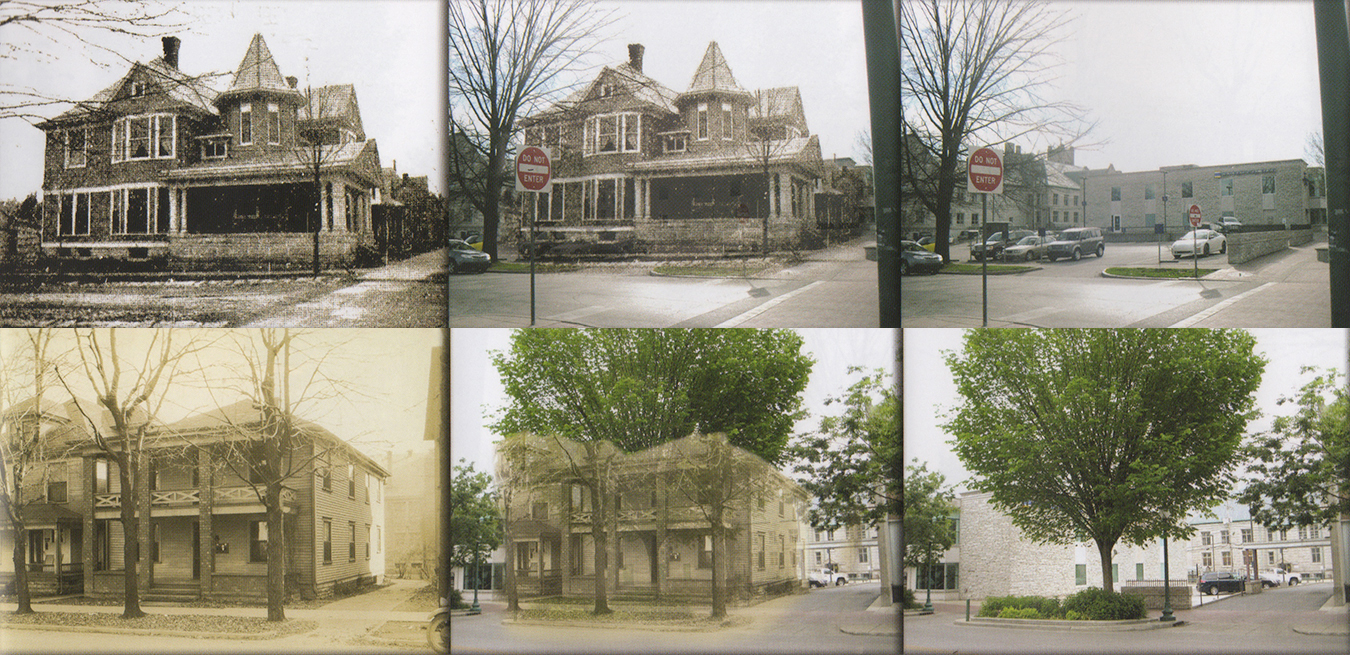
These images appear in Richey’s “Bloomington: Then & Now.” Old homes along East Kirkwood, such as 222 E. Kirkwood (top) and 206 and 208 E. Kirkwood (bottom), were frequently torn down to create parking spaces. Bloomington is currently going through another shift, with many of these parking lots being turned into apartments and hotels. | Courtesy images
“I’d already found a few older photos of Bloomington and I came to realize that a lot of the buildings in those old photos were long gone. That was a consistent theme, over and over and over again.
“The folks in the ’50s and ’60s, were very convinced they had all the answers. After World War II, they had more technology, they had more math, they were smarter. So they kind of discounted the folks from the past, what they thought about city planning, what they thought about architecture. People basically said, ‘That old stuff is garbage. That’s all caveman stuff.’ They just rolled it all up in a big wad and threw it in the fire. They said, ‘Let us show you what we can do now!’ We got to the point where it got so bad, we were celebrating the opening of parking lots. The mayor would come and there’d be a ribbon-cutting ceremony. We had just latched on to this whole concept of ‘progress.’ If you got in the way of that, you were ‘sentimental.’ There was something wrong with you.”
Richey’s different. He loves the old stuff.
“I’d go out with my camera and try to take the photo from the exact spot, at the exact angle, as the person who’d taken the original photo in 1887 or whenever. I was taking photos of parking lots or grass fields where there were no buildings left. Then I knew there was a story that I needed to figure out more about.”
So he set out to recapture Bloomington’s history.
The Bloomington Fading project, as does the book, features old black-and-white photos laid over images of the precise sites they stood on, giving readers and viewers the illusion of going back in time. One of the things he discovered was the rich residential history of Kirkwood Avenue, west of IU’s Sample Gates. The stretch is now a lively commercial district with at least two hotels under construction. A hundred years ago, Kirkwood was an entirely different place.
“People didn’t realize Kirkwood was a residential neighborhood full of huge, gigantic houses — great old beautiful Victorians and Italianates, even some Georgians,” Richey says. Those homes had real history and, occasionally, even drama. “There are some famous stories coming out of some of those homes. Well-off people, lawyers and architects, lived there. They had those houses built specifically for them but a few of them never lived in them because they’d run off with their secretaries to live in Indianapolis. There’s some fun ones.”
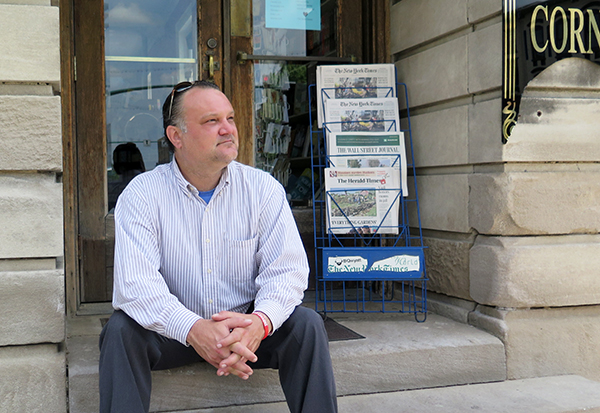
Richey sits on the steps of The Book Corner, which resides in a historic building on the east side of the downtown Square. | Limestone Post
Telling the tale of Richey’s own history might call for just as dogged a digger as he is. “I really don’t have a hometown,” he says. “I was an Army brat. People ask me where I’m from and I say, ‘I’m from everywhere.’ I was born in Fort Knox, Kentucky — not actually in the vault, but on the base. I spent most of the first six years of my life in Germany. My mother is German. My dad met her in Berlin when she was 18 and he was 21. He was a captain there. Then he kept going up the ladder so we moved from base to base. I did a count at one point and figured out I’d lived in 13 different houses by the time I finished high school.
“Change is something I had to get used to. Maybe that’s an inspiration, why I want to study why change happens.”
All the uprooting, all the moving, shaped him. “It can take a lot out of you,” Richey says. “Making new friends and leaving new friends every two or three years.” Richey says he grew into a rather reserved adult; he describes an earlier version of himself as a “shy introvert.”
It was his work documenting Bloomington’s history that made him who he is today. After his family project had hit the internet, the Monroe County Commissioners asked him to come to their meeting and make a presentation of his photos. “My first instinct was to say no,” Richey says. “Oh my God, I didn’t want to present in front of a whole lot of people who actually know a lot about Bloomington history. But I talked myself into it. And I talked myself into saying yes to a lot of things like that. I’d been living in this weird, introvert shell for years. It sapped my energy to be around a lot of people. It doesn’t anymore.”
It can be said Richey renovated himself. “Yeah, I’m a restoration as a person,” he says.
He can laugh at the suggestion because, as president of the Bloomington Restorations board, he’s instrumental in restoring and renovating old local homes that, in the past, might only have been fated for the wrecker’s ball. “We’ll purchase a house in bad condition, maybe someone will donate one to us, and we will fix it up. Then we’ll sell it, sometimes under the state’s low-income housing program.” The new owners must agree to maintain the historic exterior features of the house and they must keep the building for a certain number of years.
One such home was the farmhouse at Hinkle-Garton Farmstead at 2920 E. 10th St. It was dilapidated when its owner donated it to BRI. Now the farmhouse serves as the organization’s home base. There’s even a small historical museum in it. And now Indiana University is partnering with BRI to use the adjoining farm field for high-tech agriculture experiments.
After graduating from IU with a degree in political science and then getting a teacher’s certificate, Richey went to work at Owen Valley High School. During summers, he worked for the company now known as Solution Tree, selling magazines, videos, and books. He also did some work for a local education nonprofit. “That got me into the nonprofit world,” he says. “It’s been a slow evolution into what I’m doing now.” Bloomington Restorations is a nonprofit and his day job is regional development manager for the March of Dimes, a nonprofit that funds research and other programs to help end premature birth, birth defects, and infant mortality.
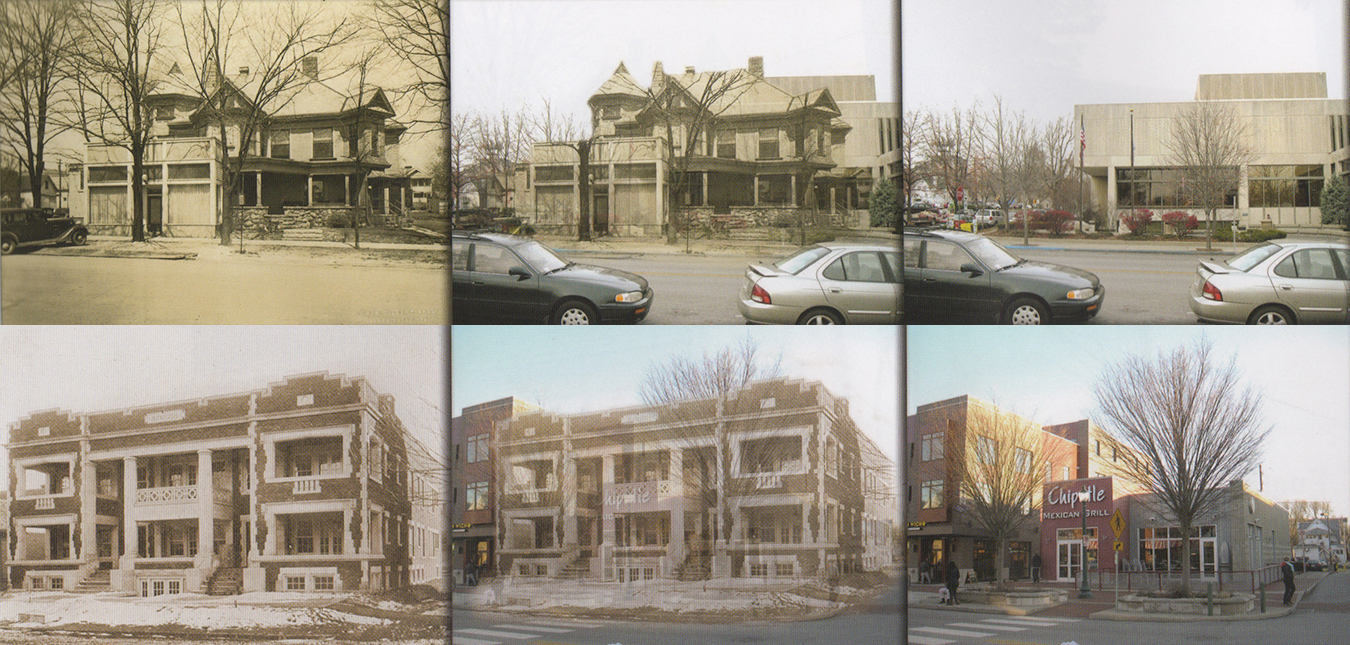
Richey assembled these photos for his book “Bloomington: Then & Now.” According to the book, a block of residential homes (top) was razed on Kirkwood around the late 1960s to make way for the Monroe County Public Library. (bottom) The Arbutus Flats once stood where Chipotle is today.
Richey says local preservationists face two challenges in the coming years. One is the wealth of beautiful old farmhouses in Monroe County and the other are the properties owned by the university within the city.
“The county is a place where we have to keep our eyes open,” he says. Monroe County does not have a protection agency like Bloomington’s Historic Preservation Commission. The commission can at least delay owners from tearing down their charming but rickety old homes. The commissioners also often persuade those owners to renovate their buildings, increasing their resale value.
As for the university, Richey says the current administration is cooperative with preservationists. “We have this great relationship with the university,” Richey says. “When it has a structure that it wants to tear down, like it did along South Dunn a number of years ago, its leaders come to us and say, ‘We’ll help you move it. Where do you want it? Find a lot and we’ll donate it to you.’
“That’s something the community’s going to have to keep an eye on,” he says. “That relationship needs to be cultivated. The leadership roles are going to change. The people are going to be changed. That thinking might change.”
Richey mentions that some people call him and the many others around town trying to preserve the old Bloomington “house huggers,” a takeoff on the rusty eco-insult, “tree huggers.”
“But we really are house huggers,” he happily admits. “That’s what we’re here to do: save as much as we can that gives our community so much character. That’s why people want to live in Bloomington in the first place.”
[Editor’s note: Michael G. Glab’s full interview with Derek Richey can be heard today on his radio show, Big Talk, which runs on WFHB (91.3 FM, 98.1 Bloomington, 100.7 Nashville, 106.3 Ellettsville) every Thursday at 5:30 p.m. and will be available, along with podcasts of past shows, at WFHB.org. Each of Glab’s monthly profiles for Limestone Post is based on one of his Big Talk interviews and will be posted on the same day that the interview airs on Big Talk.]

